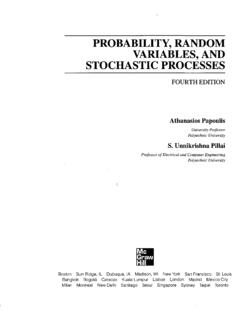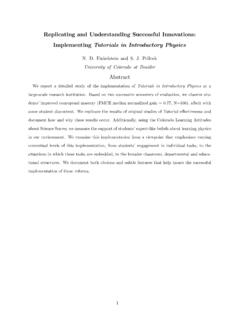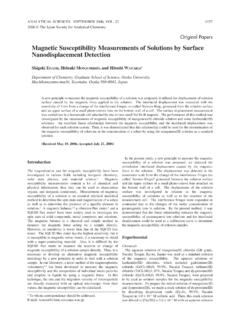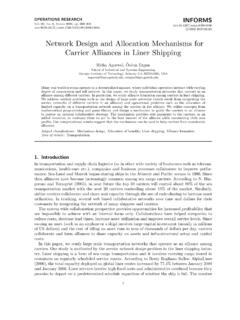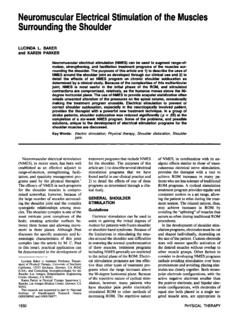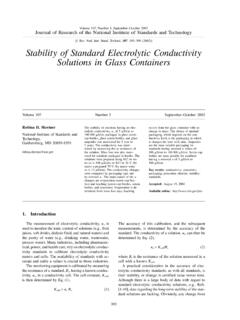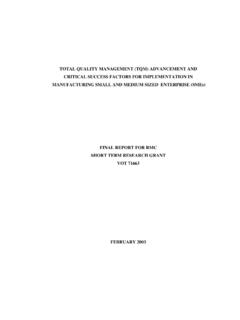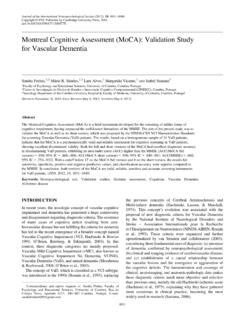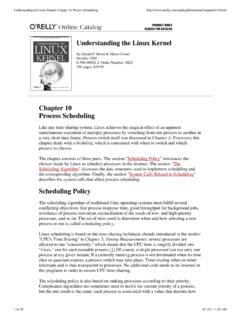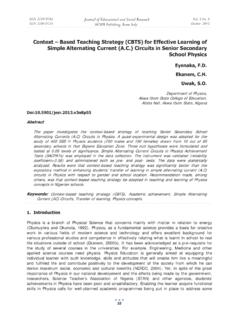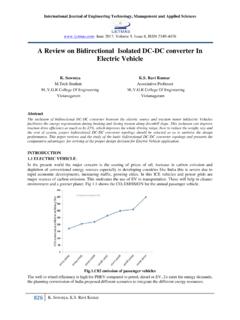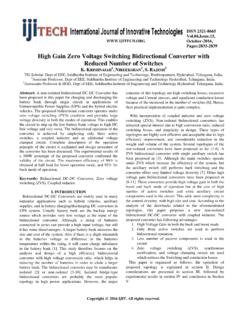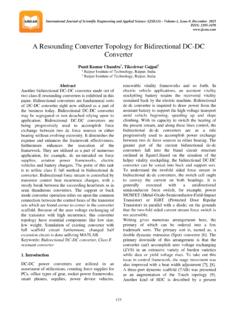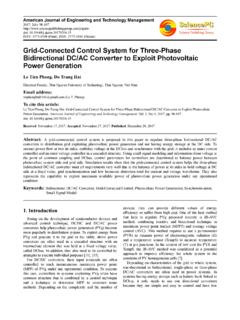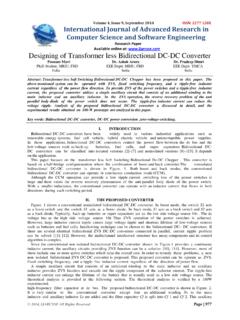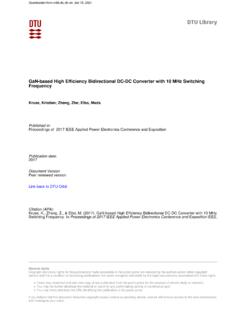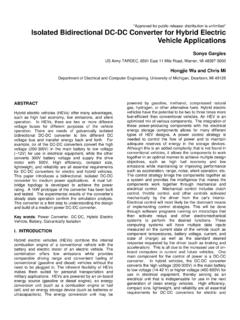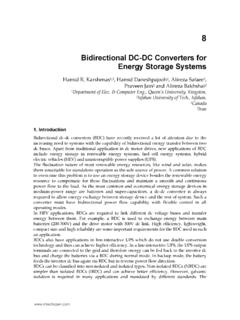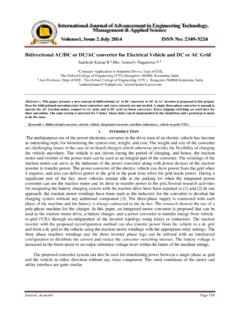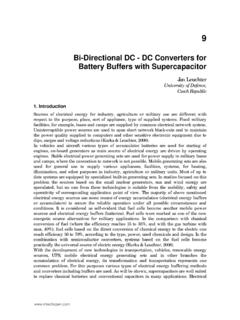Transcription of Design and Implementation of a Bidirectional DC-DC ...
1 International Journal of Computer, Consumer and Control (IJ3C), Vol. 2, (2013) Design and Implementation of a Bidirectional DC-DC converter for stand - alone photovoltaic Systems 1*Kuei-Hsiang Chao, 1 Ming-Chang Tseng, 1 Chun-Hao Huang, 2Ya n g-Guang Liu and 2 Liang-Chiao Huang Abstract In this study, we focused on developing a Bidirectional power converter for a stand - alone photovoltaic power generation system and system energy management when a lithium-iron battery is used to regulate the power supply. We used a small-scale air-conditioner to provide the load for the Bidirectional power converter developed in this study to examine the efficiency of the converter and the performance of energy management systems.
2 The overall framework of the proposed system comprised a maximum power point tracking controller, Bidirectional buck-boost converter , lithium-iron battery, small-scale air-conditioner, and energy management system. An energy management strategy was proposed to increase the power utilization rate of the photovoltaic power generation system. Some measurement results are made to verify the feasibility of an air conditioner system with a photovoltaic power generation system and lithium-iron battery hybrid power supply. Keywords: photovoltaic (PV) generation system, small-scale air-conditioner, power management strategy, energy management strategy.
3 1. Introduction As business and industrial requirements and people s needs increase, the demand for small-scale air-conditioners in general households and office spaces have risen dramatically. However, the greater power loads of small-scale air-conditioners have caused power companies to increase the reserve margin during peak power usage times in the summer. Therefore, using the energy produced by photovoltaic power systems effectively, many studies has been investigating the development of a photovoltaic power generation system with energy management properties for small-scale air conditioners and methods to reduce peak power loads [1-3].
4 Furthermore, identical to most renewable energy sources, photovoltaic power generation systems also provide a direct current (DC) power supply. Therefore, this research tends to enhancing the energy conversion efficiency of photovoltaic power generation systems by increasing the efficacy of photovoltaic power generation systems applied to small-scale air-conditioners, and supplied the DC power produced by photovoltaic power generation systems to inverter-fed small-scale air-conditioners [4-8]. The energy management framework of stand - alone photovoltaic power generation systems can provide a stable power supply for small-scale air-conditioners using a Bidirectional buck-boost converter with battery charging and discharging characteristics.
5 In the framework of general Bidirectional buck-boost converters, the diode component of the boost converter is substituted with a power semiconductor switch. Consequently, a synchronous rectification framework and Bidirectional energy flow characteristics are provided for the converter . The switch conduction losses can be reduced by applying a synchronous rectification framework [9-15] to increase the energy conversion efficiency provided for comparing to that of general boost converters. To appropriately employ the power output of the photovoltaic power generation system, we combined the Bidirectional buck-boost converter developed in this study with a lithium-iron rechargeable battery.
6 Furthermore, we proposed a small-scale air-conditioner energy management strategy based on a hybrid power supply provided by a photovoltaic power generation system and lithium-iron rechargeable battery to increase the photovoltaic power generation system s stable supply of power. *CorrespondingAuthor: Kuei-Hsiang Chao (E- 1 Department of Electrical Engineering, National Chin-Yi University of Technology, 57, Sec. 2, Zhongshan Rd., Taiping Dist., Taichung 41170, Taiwan 2 Green Energy & Environmental Research Laboratories (GEL) of ITRI , Ta i w a n 44 International Journal of Computer, Consumer and Control (IJ3C), Vol. 2, (2013) 2. System Framework Figure 1 shows the power converter system framework of the stand - alone photovoltaic power generation system [16].)
7 This framework combines a maximum power point tracking controller and a Bidirectional buck-boost converter equipped with a charge and discharge control function. The battery charge and discharge controller employ a Bidirectional buck-boost converter that simultaneously exhibits the energy conversion characteristics of buck and boost converters. Thus, the energy conversion efficiency is significantly increased. Furthermore, this converter in the system framework provides not only battery energy storage functions, but also facilitates auxiliary power supply at the load terminal. By implementing the system characteristics are mentioned previously, the power supply can be managed and controlled.
8 The maximum power point tracking controller is focused on tracking and controlling the output power of the photovoltaic module array. Therefore, the system s DC link voltage (VH) varies according to solar irradiation and tracking processes. If VH is directly connected to the load terminal system, the system will become compromised. Therefore, we proposed a control strategy that allowed VH to be controlled at a 350V setting through the charge and discharge control function of a Bidirectional buck-boost DC-DC converter . The control method involves adopting the error between of the DC link voltage VH and its command value (*HV) to further obtain the battery charge/discharge current command value (*oI) through the DC link voltage controller.
9 Subsequently, the hysteresis current controller senses the charge and discharge current (IL) of the battery to follow its command value to achieve DC link voltage (VH) regulatory functions. Additionally, to prevent excessive IL, the system restricts the maximum charging current. Therefore, when the charging current exceeds the default value, the system discontinues the maximum power tracking procedure to protect the battery from damage. This control strategy enables the photovoltaic module array to maintain a maximum power output under various solar irradiation intensities. Additionally, the DC link control strategy is employed to achieve DC link voltage (VH) control.
10 Furthermore, the control system adopts proportional-integral controllers (PI controllers) that are easily implemented. The parameters of the DC link voltage controller are KPv = and KIv = , and the parameters of the hysteresis current controller are KPi = and KIi = Boost converterArrayPVMPPT controllerMPPT controller Bidirectional buck-boost converterDC link voltage controllerDC link voltage controllerCurrent controllerBatteryAir conditionerIpvVpvVpvIpvCHCLILILVLVHVHVH* Io* Figure 1: System framework of the photovoltaic power generation system applied to small-scale air-conditioners 3. The Proposed Bidirectional Buck-Boost converter To facilitate power storage generated from stand - alone photovoltaic power generation systems during overproduction, it provides the stored power as an auxiliary service during electricity shortages.
